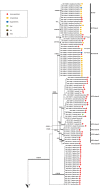Phylogeography and evolutionary patterns in Sporothrix spanning more than 14 000 human and animal case reports
- PMID: 26823625
- PMCID: PMC4713101
- DOI: 10.3767/003158515X687416
Phylogeography and evolutionary patterns in Sporothrix spanning more than 14 000 human and animal case reports
Abstract
Pathology to vertebrate hosts has emerged repeatedly in the order Ophiostomatales. Occasional infections have been observed in Sporothrix mexicana at a low level of virulence, while the main pathogenic species cluster in a derived clade around S. schenckii s.str. In this paper, phylogeny and epidemiology of the members of this clade were investigated for 99 clinical and 36 environmental strains using four genetic loci, viz. rDNA ITS and partial CAL, TEF1, and TEF3; data are compared with amplified fragment length polymorphism (AFLP) genotyping. The four main species of the pathogenic clade were recognised. The species proved to show high degrees of endemicity, which enabled interpretation of literature data where live material or genetic information is lacking. The clade of four species comprised nine subclusters, which often had limited geographic distribution and were separate from each other in all partitions, suggesting low degrees of interbreeding between populations. In contrast, S. globosa exhibited consistent global distribution of identical AFLP types, suggesting another type of dispersal. Sporothrix brasiliensis is known to be involved in an expanding zoonosis and transmitted by cats, whereas S. globosa infections originated from putrid plant material, causing a sapronosis. Sporothrix schenckii s.str., the most variable species within the clade, also had a plant origin, with ecological similarities to that of S. globosa. A hypothesis was put forward that highly specific conditions in the plant material are required to promote the growth of Sporothrix. Fermented, self-heated plant debris may stimulate the thermodependent yeast-like invasive form of the fungus, which facilitates repeated infection of mammals.
Keywords: Sporothrix; epidemiology; historical biogeography; phylogeny; sapronosis; sporotrichosis; transmission routes; yeast conversion; zoonosis.
Figures











References
-
- Agarwal S, Gopal K, Umesh , et al. 2008. Sporotrichosis in Uttarakhand (India): a report of nine cases. International Journal of Dermatology 47: 367–371. - PubMed
-
- Ajello L, Kaplan W. 1969. A new variant of Sporothrix schenckii. Mycoses 12: 633–644. - PubMed
-
- Al-Tawfiq JA, Wools KK. 1998. Disseminated sporotrichosis and Sporothrix schenckii fungemia as the initial presentation of human immunodeficiency virus infection. Clinical Infectious Diseases 26: 1403–1406. - PubMed
-
- Alberici F, Paties CT, Lombardi G, et al. 1989. Sporothrix schenckii var. luriei as the cause of sporotrichosis in Italy. European Journal of Epidemiology 5: 173–177. - PubMed
-
- Alessio DJ d’, Leavens LJ, Strumpf GB, et al. 1965. An outbreak of Sporotrichosis in Vermont associated with Sphagnum moss as the source of infection. New England Journal of Medicine 272: 1054–1058. - PubMed
LinkOut - more resources
Full Text Sources
Miscellaneous
